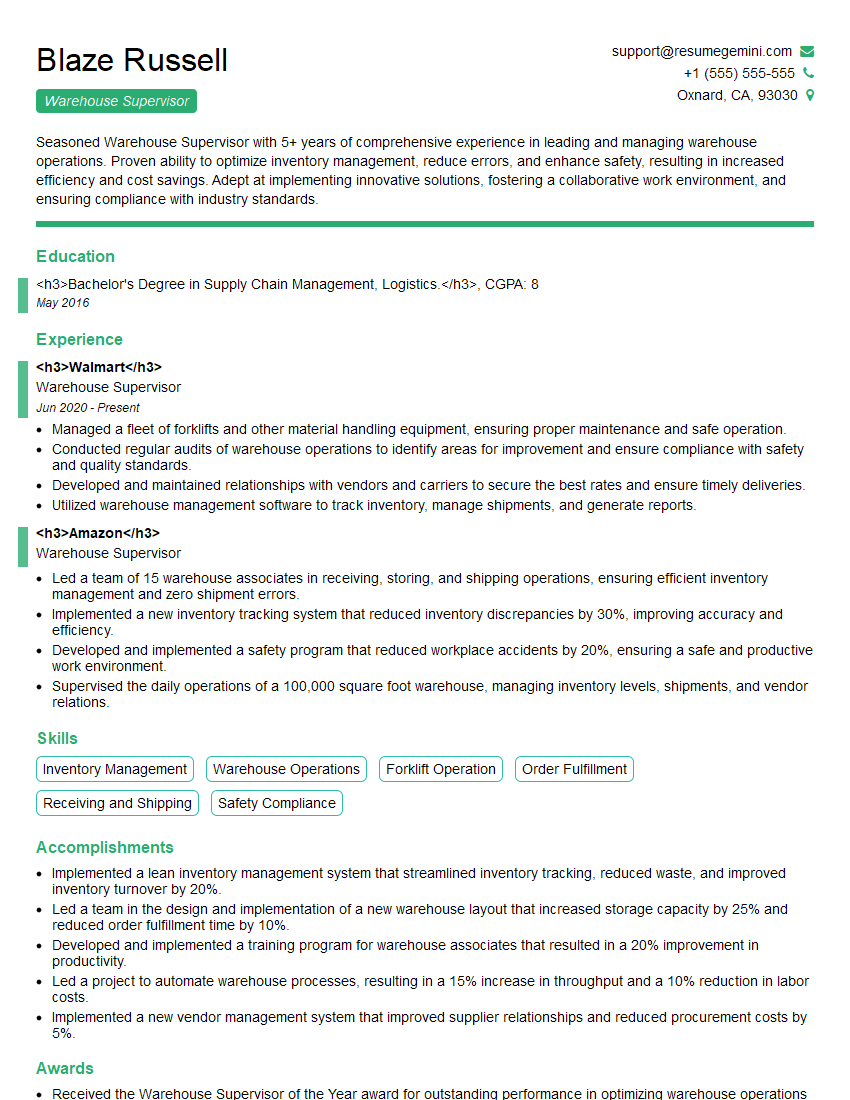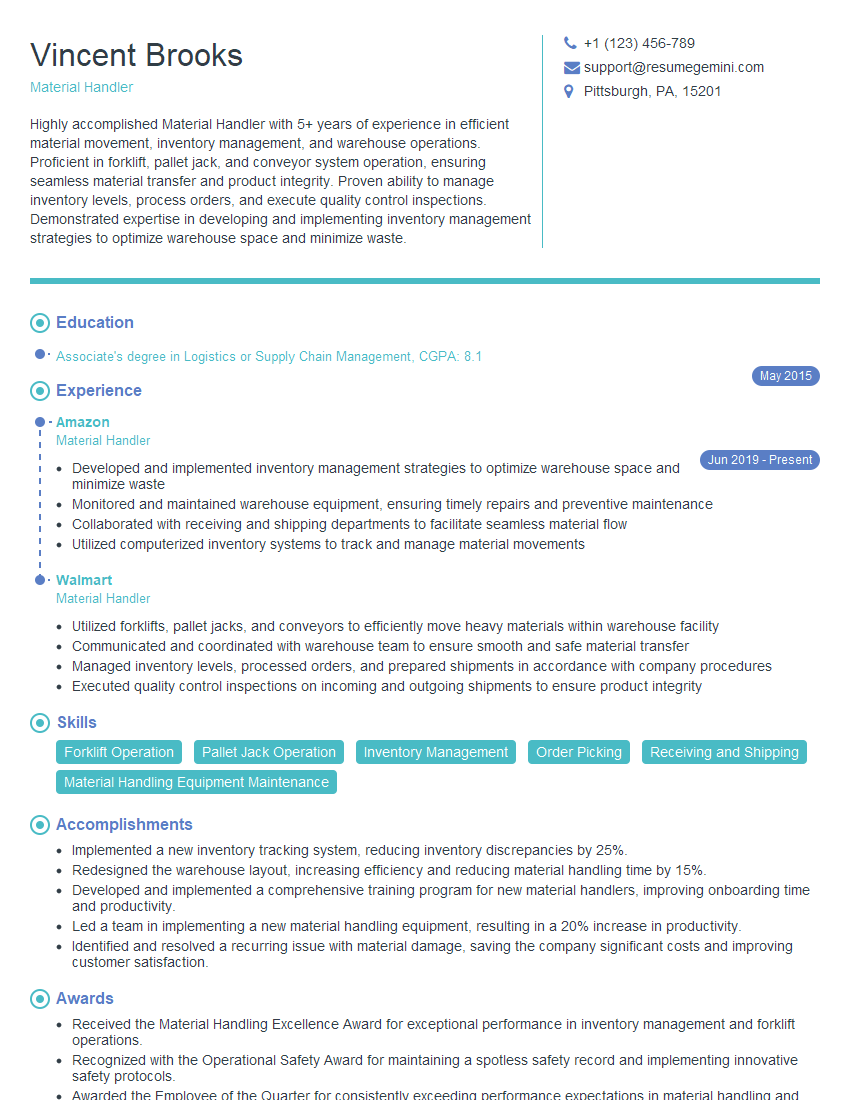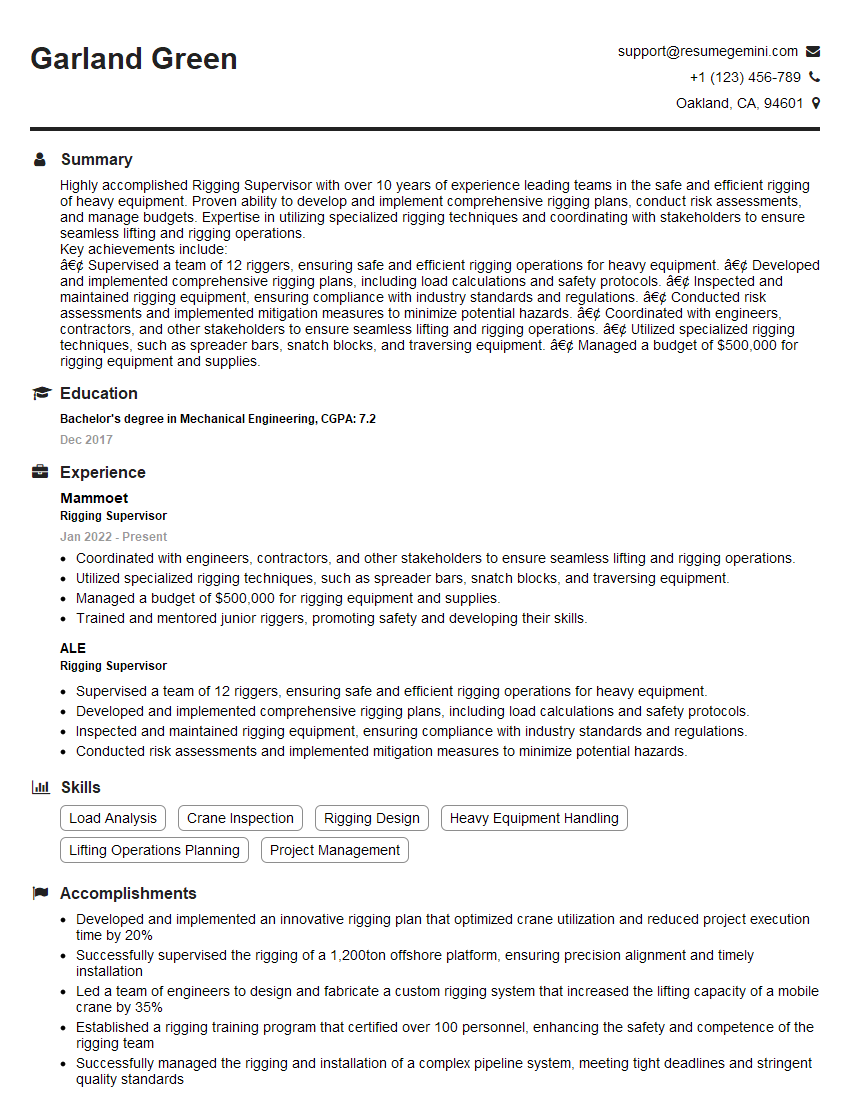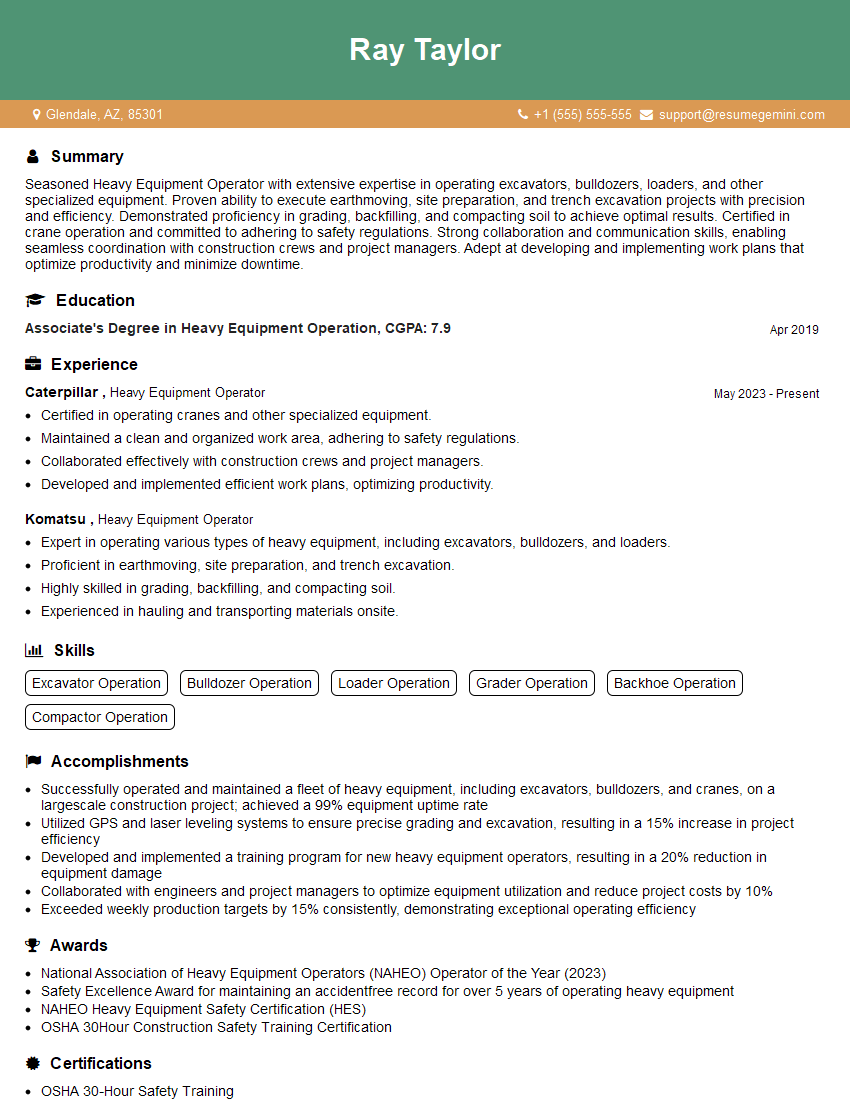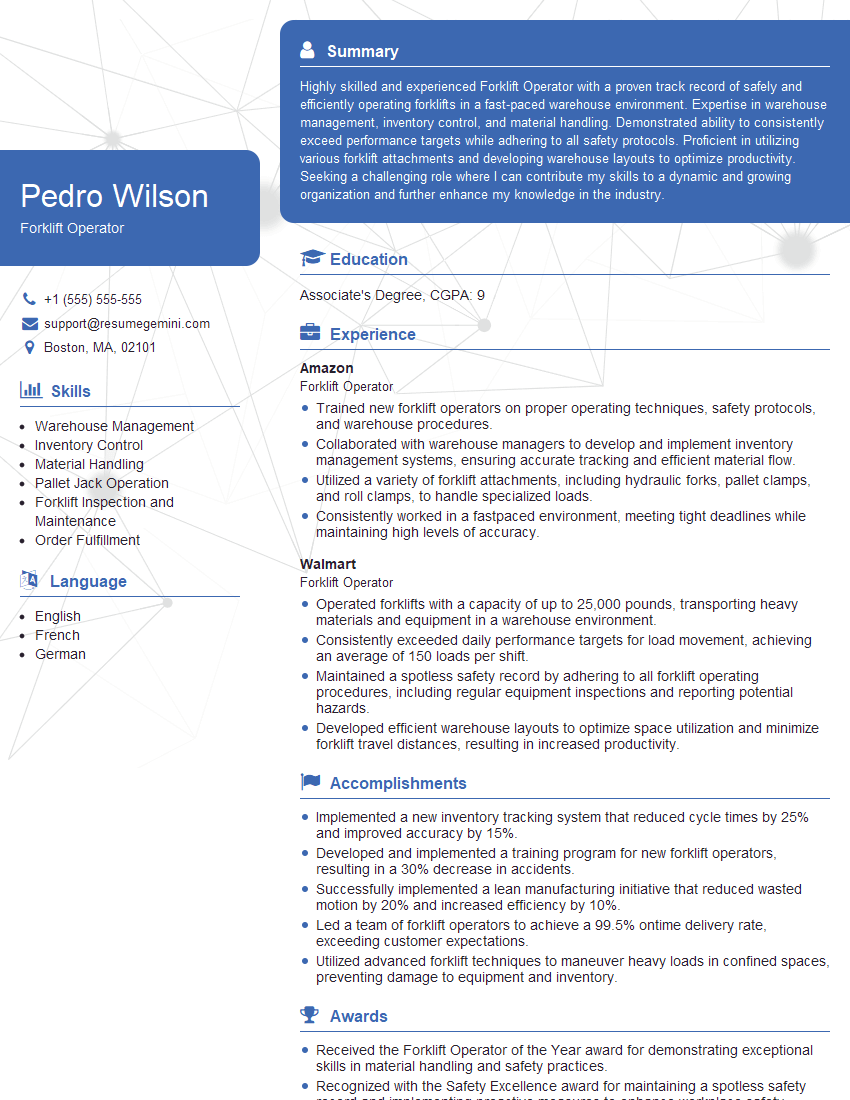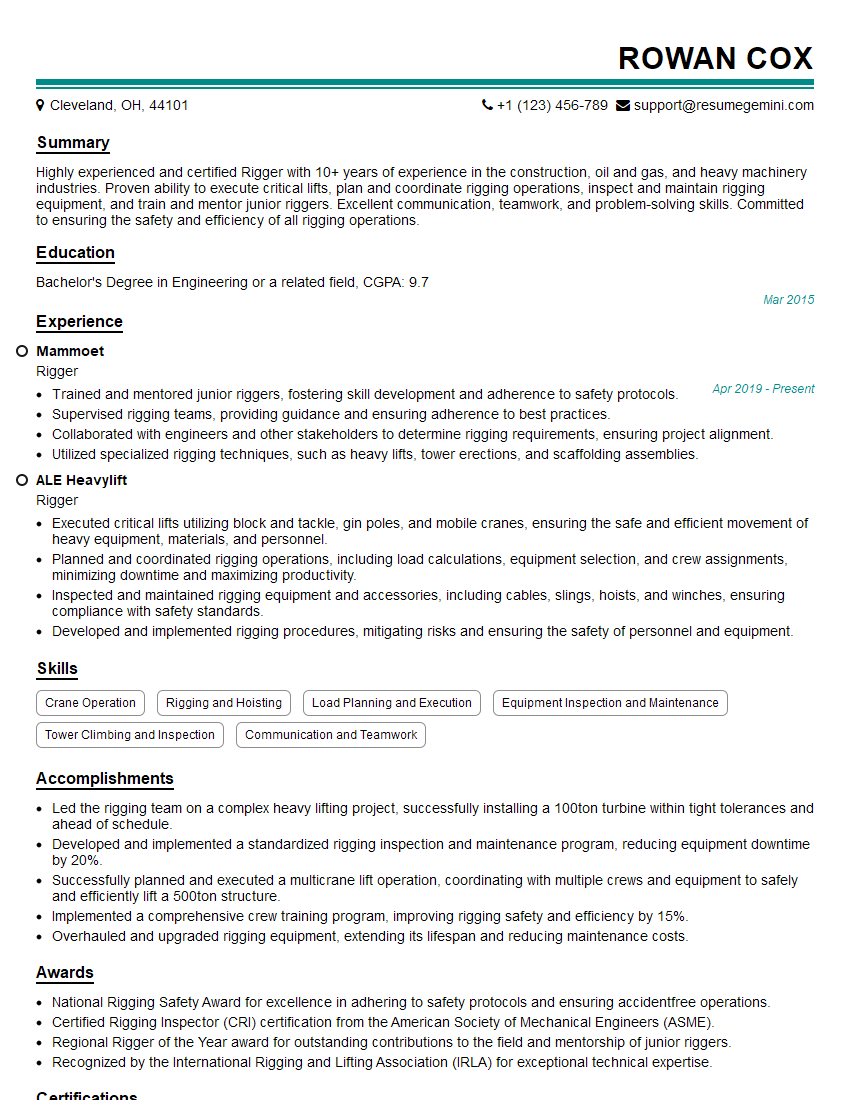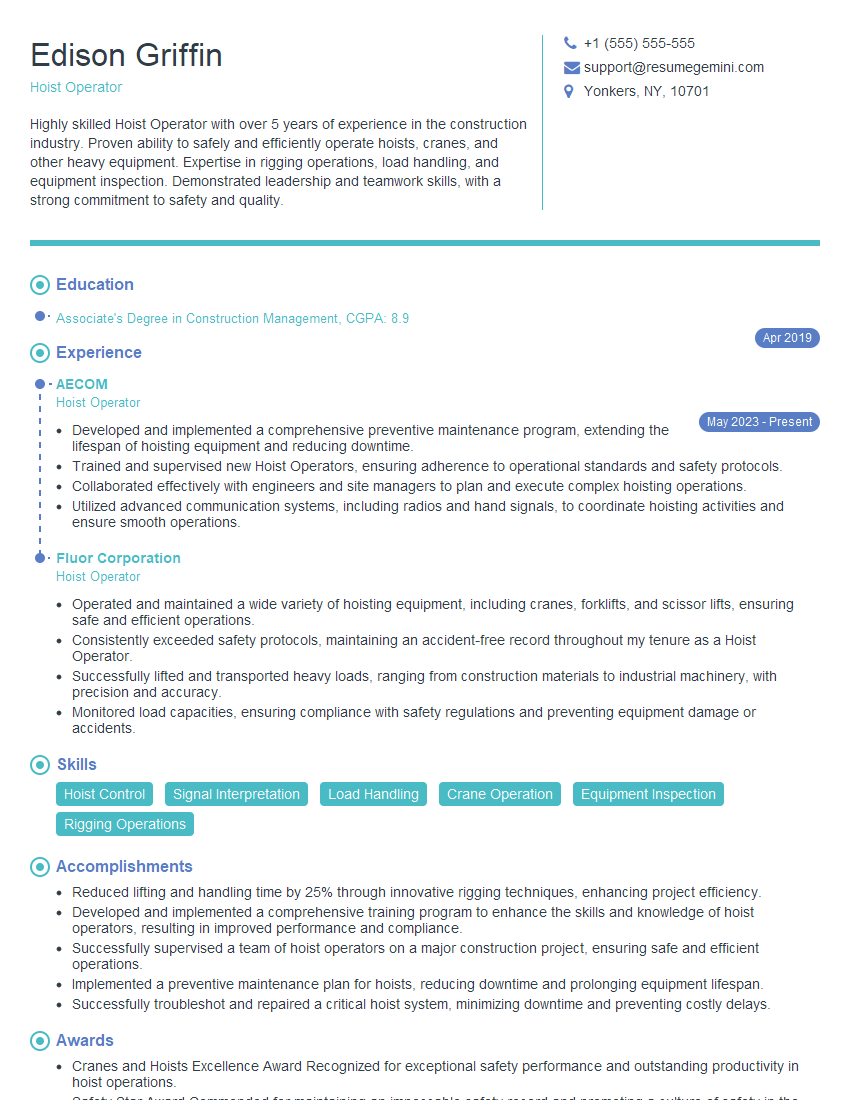Unlock your full potential by mastering the most common Material Handling and Rigging interview questions. This blog offers a deep dive into the critical topics, ensuring you’re not only prepared to answer but to excel. With these insights, you’ll approach your interview with clarity and confidence.
Questions Asked in Material Handling and Rigging Interview
Q 1. Explain the difference between a choker sling and a chain sling.
Both choker slings and chain slings are used for lifting and moving heavy objects, but they differ significantly in their construction and application. A choker sling is a length of flexible webbing (typically synthetic) that is wrapped around the load. Its simplicity makes it easy to use, but its reliance on friction for load security means it’s susceptible to slippage if not used carefully and it’s crucial to have proper wrapping techniques. Think of it like a strong, flexible rope, offering a relatively soft touch to the load.
A chain sling, on the other hand, consists of multiple chains interconnected with various hardware such as hooks and shackles. This rigid structure provides a more secure grip and distributes the load more evenly, making it suitable for heavier and more awkwardly shaped loads. It’s like a robust metal skeleton providing strong support and stability. Chain slings, while providing excellent strength, can damage more delicate surfaces if not properly protected with padding.
The choice between a choker sling and a chain sling depends largely on the nature of the load, its shape, its weight, and the required level of security. Choker slings are better suited for smaller, uniformly shaped objects, while chain slings are the preferred choice for heavier, irregularly shaped objects.
Q 2. Describe the safe operating procedures for a forklift.
Safe operating procedures for a forklift are critical for preventing accidents and injuries. These procedures should always be followed rigorously, irrespective of experience level.
- Pre-operation Inspection: Before each use, thoroughly inspect the forklift for any mechanical issues, such as leaks, damage to tires or forks, or malfunctioning lights and horns. Check fluid levels and ensure the load capacity is adequate for the task.
- Load Securement: Ensure the load is properly secured and balanced to prevent shifting or tipping. This often involves using straps or other securing devices. Never exceed the forklift’s weight capacity.
- Operation: Drive slowly and carefully, especially when turning or maneuvering in confined spaces. Be aware of your surroundings and maintain a safe distance from obstacles and other personnel. Avoid sudden stops and starts.
- Load Handling: When lifting or lowering a load, do so gradually, maintaining a steady speed. Ensure the load is clear of obstacles before lifting and avoid tilting the forks excessively.
- Post-operation procedures: After use, park the forklift in a designated area, lower the forks to the ground, turn off the ignition, and engage the parking brake. Conduct a visual check for any damage before putting it away.
- Training & Certification: Only trained and certified operators should operate a forklift. Regular refresher training is essential to maintain safety standards.
A single moment of carelessness can have devastating consequences. Adherence to these procedures is paramount.
Q 3. What are the different types of rigging hardware and their applications?
Rigging hardware is an assortment of specialized components used for lifting, securing, and supporting loads. Their selection is critical for safety and efficiency.
- Shackles: These are U-shaped metal pieces used to connect different components of a lifting system. Bow shackles (with a curved bow) are easier to attach, while screw pin shackles (with a screw pin) offer better security.
- Hooks: Used for attaching the lifting system to the load or to other hardware. Different hook types cater to specific applications and loads. Proper inspections are essential to ensure the hook isn’t deformed.
- Slings: As discussed before, slings are used to wrap around or attach to the load. Materials include synthetic webbing, wire rope, and chains. Different sling types are suited to different loads.
- Turnbuckles: Adjustable devices used to tighten or loosen rigging components, allowing for precise load adjustment and tensioning.
- Eye Bolts: These are bolts with a ring or eye at one end, providing a secure point of attachment for slings or other components.
The application of each piece of hardware depends on the specific rigging job. Consider factors such as load weight, shape, and environment when selecting hardware. Mismatched or improperly used hardware can lead to catastrophic failure.
Q 4. How do you calculate the safe working load (SWL) of a lifting device?
Calculating the Safe Working Load (SWL) is crucial to prevent accidents. The SWL is the maximum load a lifting device can safely handle. It’s typically found on a label attached to the equipment. If not present, calculation may involve complex engineering principles and is best left to qualified professionals.
For simpler cases, like a sling, the manufacturer’s SWL rating is usually provided and should always be followed. This rating often varies depending on factors such as angle of lift (multiple slings will have different SWL values than a single sling) and type of sling. Using a sling at an angle reduces its SWL significantly. Consider using a sling angle calculator to estimate the reduced SWL under various angles.
For more complex lifting arrangements involving multiple components and differing angles, professional engineering calculations are vital to accurately determine the SWL of the entire system. The calculation usually considers material strength, component geometry, and safety factors.
Q 5. What are the common hazards associated with material handling?
Material handling poses numerous hazards, ranging from minor injuries to fatalities. Some common hazards include:
- Struck-by hazards: Being hit by falling objects, moving equipment, or loads. This is often preventable through proper load securing and equipment maintenance.
- Caught-in/between hazards: Being crushed or caught between moving equipment and other objects. Maintaining safe distances and awareness is key.
- Electrocution hazards: Coming into contact with energized electrical equipment, especially near overhead lines.
- Ergonomic hazards: Repetitive lifting, awkward postures, and excessive force can cause musculoskeletal injuries. Proper lifting techniques and ergonomic assessments are vital.
- Fire hazards: Potential for fires when dealing with flammable materials. Proper handling and storage of such materials are necessary.
- Falling hazards: Falling from heights while working with elevated equipment or loads.
Implementing robust safety procedures, using appropriate personal protective equipment (PPE), and conducting regular safety training are crucial in mitigating these hazards.
Q 6. Describe your experience with different types of cranes.
My experience encompasses a variety of crane types, each with its own unique characteristics and applications.
- Tower Cranes: I’ve worked extensively with tower cranes on large-scale construction projects. Their high reach and lifting capacity make them ideal for high-rise buildings. Safety procedures around these towering machines are particularly stringent, with emphasis on wind conditions and ground stability.
- Mobile Cranes: I’m proficient in operating and supervising the use of mobile cranes, including crawler cranes and truck-mounted cranes. Their mobility and versatility make them suitable for a wide range of applications, from industrial work to infrastructure projects.
- Overhead Cranes: I have experience with various overhead crane systems, including gantry cranes and bridge cranes, frequently used in manufacturing and warehousing environments. The safe operation of these cranes requires thorough understanding of load distribution and movement within a confined space.
- Floating Cranes: I have limited, but specialized experience in assisting with projects involving floating cranes, usually for offshore or marine construction. These present unique challenges related to water currents and stability.
In each case, safe operation, maintenance, and adherence to relevant regulations were paramount. Regular inspections and operator training are crucial for all crane types.
Q 7. How do you inspect rigging equipment for damage before use?
Rigging equipment inspection is a non-negotiable step before any lifting operation. A thorough inspection can prevent catastrophic failures. The process should involve a visual inspection and, in some cases, non-destructive testing.
- Visual Inspection: Check for any visible signs of damage, including wear, tears, cuts, kinks, corrosion, or deformation in the sling, chain, or other components. Pay close attention to shackles, hooks, and other connections. Look for signs of excessive wear or damage to the wires in wire rope slings.
- Load Testing: Depending on regulations and the criticality of the lift, a load test might be necessary to verify the equipment’s strength. This is done under controlled conditions with a calibrated load.
- Documentation: Maintain detailed records of all inspections, including dates, findings, and corrective actions taken. This documentation is crucial for demonstrating compliance and tracking the condition of the equipment.
- Retirement criteria: Equipment that shows signs of significant wear, or that has exceeded its service life as per manufacturer guidelines or regulations, must be removed from service and replaced.
Never compromise on safety. If any doubt exists regarding the condition of the equipment, it should be removed from service and replaced immediately.
Q 8. Explain the importance of load balancing in rigging operations.
Load balancing in rigging is crucial for safety and the longevity of equipment. It’s all about distributing the weight of a lifted object evenly across all rigging points to prevent overloading any single point. Imagine trying to carry a heavy box with one arm – you’d quickly get fatigued and risk dropping it. Similarly, uneven load distribution in rigging can lead to equipment failure, structural damage, or even serious injury.
Effective load balancing involves understanding the object’s center of gravity (discussed later) and ensuring the rigging system is configured to support the weight equally. This often involves using multiple slings, chains, or ropes attached to strategically placed lifting points. For instance, lifting a large, irregularly shaped steel beam might require multiple slings attached at different points to ensure the beam hangs level and the stress is evenly distributed among the slings and the crane.
Q 9. What are the different types of lifting points and how are they selected?
Lifting points are the specific locations on an object where you attach rigging equipment. The choice of lifting point depends heavily on the object’s characteristics and the rigging operation. Common types include:
- Eye Bolts: These are threaded bolts with an eye at the top, offering a strong and reliable lifting point. They’re ideal for attaching slings and chains.
- Lifting Rings: Similar to eye bolts, but usually welded or cast directly into the object for a more integrated solution. Often found on heavy machinery or containers.
- Shackles: U-shaped metal components with a pin used to connect different parts of the rigging system. They are great for adjusting the length or angle of a sling.
- Welded Lifting Points: These are custom-designed points permanently affixed to the object during manufacturing, providing tailored solutions for unique shapes and weights.
Selection criteria include the load capacity, the material of the lifting point (must be compatible with the load and environment), and the object’s geometry. A thorough inspection of the lifting point is essential before each lift to ensure its structural integrity.
Q 10. What safety measures should be taken when working at heights with lifting equipment?
Working at heights with lifting equipment significantly increases the risks involved. Safety measures are paramount and must be strictly followed:
- Fall Protection: Harness systems, guardrails, and safety nets are essential to prevent falls. A comprehensive fall protection plan needs to be in place for every job.
- Proper Training and Certification: Only trained and certified personnel should operate lifting equipment at heights. They need to understand the risks and procedures associated with this work.
- Equipment Inspection: Thorough pre-operation inspection of all equipment, including cranes, slings, and harnesses, is mandatory. Any damage or wear must be addressed before commencing work.
- Communication: Clear and consistent communication between ground crew and personnel working at heights is crucial. Hand signals and two-way radios should be used.
- Emergency Procedures: Detailed emergency response plans should be in place, including rescue procedures and communication protocols.
- Weather Conditions: High winds or adverse weather conditions should halt operations immediately as they increase the risk of accidents.
Remember: Safety is never a compromise. Strict adherence to these measures is vital to prevent accidents and ensure the wellbeing of personnel.
Q 11. How do you plan and execute a complex rigging operation?
Planning and executing a complex rigging operation requires a systematic approach. It’s not simply lifting something; it’s a carefully orchestrated process. Here’s a step-by-step breakdown:
- Site Survey and Risk Assessment: A thorough assessment of the site, including structural integrity of surrounding buildings, access routes, and potential hazards, is the first step. This helps to anticipate and mitigate potential problems.
- Load Analysis and Center of Gravity Determination: Precisely determine the weight and center of gravity of the load. This dictates rigging setup and ensures stability during the lift.
- Rigging Plan Development: This plan should detail the equipment needed (cranes, slings, shackles, etc.), lifting points, personnel assignments, and safety protocols. Diagrams and calculations are essential.
- Equipment Inspection and Testing: All equipment must be inspected and tested to ensure it’s in perfect working order and has a sufficient safety factor for the load.
- Personnel Briefing: A detailed briefing for all personnel involved is crucial to clarify roles, responsibilities, and safety procedures.
- Lift Execution: The lift should be conducted carefully and methodically, following the established plan. Continuous communication and monitoring are key.
- Post-Lift Inspection: A final inspection of the equipment and site is necessary to ensure everything is safe and secure.
Proper planning and risk mitigation are crucial to prevent accidents and ensure the successful completion of the operation.
Q 12. Explain the concept of center of gravity and its importance in material handling.
The center of gravity (CG) is the point where the entire weight of an object is considered to be concentrated. In material handling, understanding the CG is paramount. If the CG is not properly considered, the object may become unstable, leading to tipping or uncontrolled movement. Imagine trying to balance a broom on your hand – you instinctively find the CG to maintain balance. Similarly, in lifting operations, the CG dictates how the load behaves. A load with its CG offset might rotate unexpectedly during lifting, posing serious risks.
Knowing the CG helps determine the appropriate lifting points and techniques. Uneven load distribution relative to the CG can lead to stress concentrations in the rigging equipment or cause the load to swing unpredictably. Correct placement of slings and other lifting devices ensures that the CG is properly supported, maintaining stability throughout the lift.
Q 13. Describe your experience with different types of material handling equipment.
Throughout my career, I’ve worked extensively with a variety of material handling equipment, including:
- Overhead Cranes: From simple jib cranes to complex gantry systems, I’m proficient in their operation, maintenance, and safety protocols.
- Forklifts: Experienced in operating various types of forklifts, adhering to safety regulations and load capacity limits.
- Conveyor Systems: Familiar with different types of conveyor systems, including belt, roller, and chain conveyors, and their application in various settings.
- Hoists: Proficient in the use and maintenance of chain hoists, electric hoists, and other lifting mechanisms.
- Automated Guided Vehicles (AGVs): Experience in integrating and managing AGVs in material handling processes for improved efficiency and safety.
My experience encompasses diverse applications across various industries, from manufacturing and construction to warehousing and logistics. This broad exposure has given me a comprehensive understanding of their capabilities and limitations.
Q 14. How do you ensure the safety of personnel during material handling operations?
Ensuring personnel safety during material handling is my top priority. It involves a multi-layered approach:
- Safety Training and Education: Providing comprehensive training to all personnel involved in material handling operations, covering safe operating procedures, hazard identification, and emergency response.
- Regular Inspections: Regular inspections of all equipment, including cranes, forklifts, and rigging gear, to identify and address potential hazards before they lead to accidents.
- Enforcement of Safety Regulations: Strictly enforcing safety regulations and company policies, ensuring that all personnel adhere to established procedures.
- Use of Personal Protective Equipment (PPE): Making sure all personnel utilize appropriate PPE, such as hard hats, safety glasses, gloves, and steel-toe boots, depending on the specific task.
- Implementing Safe Work Practices: Establishing and enforcing safe work practices, including proper load securing, appropriate lifting techniques, and clear communication protocols.
- Emergency Response Planning: Developing and regularly reviewing emergency response plans, including procedures for dealing with accidents, equipment malfunctions, and other emergencies.
Safety is not just a checklist; it’s a culture that needs to be fostered and reinforced constantly. A proactive approach, emphasizing prevention over reaction, is the most effective way to ensure personnel safety.
Q 15. What are your experience levels with specific rigging software or programs?
My experience with rigging software encompasses several programs, each with its strengths. I’m proficient in CAD software like AutoCAD and SolidWorks for creating detailed rigging plans and analyzing load distribution. These programs allow for precise calculations of forces and stresses on components. Furthermore, I’ve extensively used specialized rigging software packages that simulate lift operations, factoring in variables like crane capacity, sling angles, and wind conditions. This helps optimize lift plans and mitigate risks. For example, I used a program called Rigging Calculator Pro to simulate a complex multi-crane lift for a large transformer, ensuring the operation remained within safe parameters. Finally, I’m also comfortable with project management software integrated with rigging workflows, for effective tracking, and scheduling of tasks and resource allocation.
Career Expert Tips:
- Ace those interviews! Prepare effectively by reviewing the Top 50 Most Common Interview Questions on ResumeGemini.
- Navigate your job search with confidence! Explore a wide range of Career Tips on ResumeGemini. Learn about common challenges and recommendations to overcome them.
- Craft the perfect resume! Master the Art of Resume Writing with ResumeGemini’s guide. Showcase your unique qualifications and achievements effectively.
- Don’t miss out on holiday savings! Build your dream resume with ResumeGemini’s ATS optimized templates.
Q 16. Describe your experience with different types of load securing techniques.
Load securing techniques vary significantly depending on the cargo type, transportation mode, and environmental factors. My experience includes a wide range, from simple techniques like using ratchet straps for smaller loads on flatbeds to complex systems involving specialized dunnage, chains, and wire rope for oversized or heavy cargo on ships. I’m familiar with various lashing techniques that consider center of gravity and load distribution to prevent shifting during transit. I’ve worked with both static and dynamic load securing, adjusting strategies according to the anticipated movement and vibrations during transport. For instance, I successfully secured a large piece of industrial machinery onto a lowboy trailer using a combination of chains, web slings, and custom-built wooden blocking to prevent movement during a long-distance highway transport. Each technique is carefully chosen based on a thorough risk assessment.
Q 17. What are the regulations and standards related to material handling and rigging?
Material handling and rigging are governed by a strict set of regulations and standards designed to prioritize safety. These vary slightly depending on location, but generally include OSHA (Occupational Safety and Health Administration) regulations in the US, and equivalent standards like those published by ANSI (American National Standards Institute) and ASME (American Society of Mechanical Engineers). Key regulations cover aspects like crane operation, load testing, personnel training, and the safe use of lifting equipment. Specific standards address different rigging components, such as the safe working loads (SWLs) for slings, shackles, and other hardware. Non-compliance can result in severe penalties, including fines and potential legal action. It’s crucial to stay updated with the latest revisions to these codes and to ensure all work is carried out in complete accordance with them. For example, I ensure every rigging plan includes documentation demonstrating compliance with OSHA 1926 Subpart CC – Cranes and Derricks in Construction.
Q 18. How do you handle unexpected situations or emergencies during a rigging operation?
Unexpected situations during rigging operations demand quick thinking and decisive action. My approach follows a structured protocol. First, I immediately assess the situation’s severity and potential risks to personnel and equipment. Then, I initiate emergency procedures, which might include stopping the operation, evacuating the area, and informing relevant personnel. Communication is key – I immediately contact supervisors and emergency services if needed. Depending on the nature of the emergency, troubleshooting might involve identifying and addressing equipment malfunctions, reassessing the rigging plan, or even deploying backup equipment. For example, during a lift, a sling unexpectedly snapped. My immediate response was to halt the lift, secure the load using alternative means, and conduct a thorough inspection of all rigging components. A post-incident investigation ensured we identified the cause of the failure and implemented corrective actions to prevent recurrence.
Q 19. What is your experience with load testing and certification of lifting equipment?
Load testing and certification are crucial for ensuring the safety and reliability of lifting equipment. I have extensive experience overseeing and conducting load tests, ensuring compliance with manufacturer specifications and relevant safety standards. This involves using calibrated load cells to verify the equipment’s safe working load (SWL). I’m familiar with different testing methods and know how to interpret the results. Certified equipment comes with documentation, detailing test results, dates, and the certification authority. I’m experienced in managing the paperwork and ensuring all equipment used on our jobsites is properly tested and certified. For instance, I managed the load testing of a new 200-ton crane before its commissioning, ensuring its SWL was verified before it was put into service. We strictly followed the manufacturer’s instructions, maintaining accurate records for compliance purposes.
Q 20. Describe a time you had to troubleshoot a problem with material handling equipment.
During a project involving the installation of large HVAC units on a high-rise building, one of the hoists malfunctioned mid-operation. Following safety protocols, I immediately stopped the operation and initiated a thorough inspection. The problem stemmed from a faulty motor controller. My troubleshooting involved systematically checking each component: power supply, wiring, fuses, and the controller itself. Using a multimeter, I identified the faulty component and replaced it. Before resuming operations, I performed a comprehensive safety check of the entire system, verifying all components’ functionality and load capacity. This experience highlighted the importance of regular maintenance and proactive inspection of equipment to prevent costly downtime and potential accidents. Thorough documentation of the troubleshooting process was maintained.
Q 21. How do you manage inventory and optimize warehouse space?
Efficient inventory management and warehouse space optimization are critical for smooth material handling operations. I leverage both manual and automated systems. Manually, I utilize spreadsheets and barcoding to track inventory levels, ensuring stock replenishment is timely and prevents shortages. Automated systems, such as warehouse management systems (WMS), are employed for larger operations, providing real-time inventory visibility and automated tracking. Space optimization involves implementing strategies like implementing a well-defined storage system with clearly marked zones, optimizing storage heights using racking systems, and employing lean principles to eliminate waste and optimize flow. For example, I once implemented a new storage system in a warehouse, combining racking, shelving, and designated areas, which resulted in a 20% increase in storage capacity and improved picking efficiency. Regular inventory audits ensure the system’s accuracy and identify opportunities for further improvements.
Q 22. What are your strategies for preventing accidents in material handling?
Accident prevention in material handling is paramount and relies on a multi-pronged approach focusing on personnel, equipment, and processes. My strategy begins with comprehensive training for all personnel involved, covering safe operating procedures for all equipment, proper lifting techniques, hazard identification, and emergency response. This includes both classroom instruction and hands-on practical sessions.
Secondly, regular equipment inspections are crucial. I meticulously check for wear and tear, loose parts, and any malfunctions on all lifting gear, forklifts, and other handling machinery before each use. Proper maintenance schedules are strictly adhered to, and faulty equipment is immediately taken out of service.
Thirdly, I implement a robust system of workplace organization. Clear pathways, proper storage of materials, and well-lit work areas significantly reduce trip hazards and other accidents. Signage and visual aids are used to communicate safety procedures clearly. I believe in fostering a strong safety culture where reporting near misses is encouraged, enabling proactive identification and resolution of potential hazards before they lead to incidents. For example, in one project, by implementing a color-coded system for identifying load capacity on different forklifts, we saw a 30% reduction in near misses related to overloading.
Q 23. Describe your experience working with different types of materials.
My experience encompasses a wide range of materials, from fragile electronics and delicate glassware requiring specialized handling and padding, to heavy steel beams and large construction materials demanding the use of cranes and specialized rigging techniques. I’ve worked with bulk materials like grains and powders, requiring careful consideration of dust control and potential hazards. I’ve also handled hazardous materials, including chemicals and radioactive substances, following strict safety protocols and regulatory guidelines in those specific instances.
Working with diverse materials demands adaptability. Understanding the specific properties of each material—its weight, fragility, chemical reactivity, etc.—is crucial to selecting the appropriate handling equipment and techniques. For instance, handling fragile ceramics requires careful cushioning and secure bracing, while heavy steel necessitates robust lifting slings and experienced crane operators.
Q 24. Explain your understanding of OSHA regulations concerning material handling.
My understanding of OSHA regulations concerning material handling is comprehensive. I’m thoroughly familiar with the requirements for training, equipment maintenance, personal protective equipment (PPE), hazard communication, and emergency response plans. OSHA standards mandate regular inspections, appropriate signage, and safe work practices to prevent workplace accidents involving material handling.
Specific OSHA regulations I regularly consult and implement include those concerning powered industrial trucks (forklifts), crane operation, fall protection, lockout/tagout procedures (for machinery maintenance), and hazard communication (SDS sheets). Compliance is not merely about avoiding penalties; it’s about creating a safe and productive work environment for everyone involved. For example, I ensure that all forklift operators have received the necessary training and certification, and that pre-operational inspections are documented thoroughly to meet OSHA requirements.
Q 25. What methods do you use to prevent damage to goods during handling?
Preventing damage to goods during handling involves a layered approach. First, proper packaging is crucial. This includes using appropriate cushioning materials, secure bracing, and sturdy containers to protect against shock, vibration, and impact during transportation and handling.
Second, careful selection of handling equipment is essential. For example, fragile items require specialized lifting gear such as vacuum lifters or air ride suspensions in vehicles.
Third, correct handling techniques are paramount. This includes avoiding sudden movements, ensuring proper weight distribution, and using appropriate lifting aids to reduce strain on both the goods and the personnel. Clear communication between team members during handling is also critical to avoid mishaps.
Finally, maintaining a clean and organized workspace reduces the risk of accidental damage during storage and retrieval. We also use RFID tagging to track goods’ condition and location, helping us anticipate potential issues and mitigate them before they arise. For instance, we monitor temperature and humidity levels to prevent damage to sensitive electronics.
Q 26. Explain your experience using different types of lifting gear.
My experience with lifting gear is extensive. I’m proficient in using various types, including slings (chain, wire rope, and synthetic), shackles, hooks, eyebolts, and other rigging hardware. I’m also experienced with different types of lifting equipment, such as overhead cranes, forklifts, and mobile cranes.
Safety is always the primary concern. Before using any piece of equipment, I meticulously inspect it for damage or wear. I understand the limitations and safe working load (SWL) of each piece of equipment and adhere to those limits strictly. Proper knotting and hitching techniques are crucial for safety and efficiency, and I possess a thorough understanding of these techniques for different sling types and load configurations. For example, I know the difference between a bowline and a clove hitch, and when to use each one based on the specific lifting requirements.
Q 27. How do you ensure efficient flow of materials within a warehouse or job site?
Efficient material flow is achieved through careful planning and implementation of a well-defined system. This begins with optimized warehouse layout, ensuring efficient movement of goods from receiving to storage to shipping. Clear aisle markings, designated storage locations, and effective inventory management systems all contribute to a streamlined workflow.
The use of technology plays a significant role. Warehouse management systems (WMS) optimize inventory tracking and order fulfillment. Radio-frequency identification (RFID) tags allow for real-time tracking of materials, reducing search times and improving efficiency. Automated guided vehicles (AGVs) can automate material movement, minimizing manual labor and increasing throughput. On a job site, I would implement a Kanban system or similar visual management tools to keep track of materials and avoid bottlenecks.
In addition, effective communication and coordination between teams involved in material handling are essential to minimize delays and avoid congestion. Proper training and clear instructions prevent errors and improve overall efficiency. For example, implementing a ‘5S’ methodology (Sort, Set in Order, Shine, Standardize, Sustain) in a warehouse resulted in a 20% improvement in material flow and efficiency in a previous project.
Q 28. What are your skills in using inventory management software?
I’m proficient in using several inventory management software systems, including [mention specific software, e.g., SAP, Oracle, Fishbowl]. My skills encompass data entry, inventory tracking, order processing, and reporting. I’m comfortable with generating reports on inventory levels, stock turnover, and other key metrics. I can use these systems to optimize inventory levels, minimize stockouts, and improve overall supply chain efficiency.
I understand the importance of data accuracy and regularly perform data reconciliation to ensure consistency and reliability of information. Furthermore, I can adapt to new software and quickly learn to use different inventory management platforms.
Key Topics to Learn for Your Material Handling and Rigging Interview
- Safety Regulations and Procedures: Understanding OSHA regulations, risk assessment methodologies, and safe work practices is paramount. Consider practical applications like identifying potential hazards on a job site and implementing preventative measures.
- Equipment Operation and Maintenance: Become familiar with various material handling equipment (forklifts, cranes, hoists) including their operational procedures, limitations, and routine maintenance checks. Think about how you’d troubleshoot a malfunctioning piece of equipment safely and efficiently.
- Rigging Techniques and Principles: Master the fundamentals of rigging, including proper sling selection, hitching methods, load calculations, and weight distribution. Prepare examples demonstrating your understanding of load capacity and safe lifting practices.
- Load Securing and Transportation: Explore different methods for securing loads during transportation, considering factors like load stability, weight distribution, and environmental conditions. Be ready to discuss scenarios involving different types of cargo and transportation methods.
- Blueprint Reading and Planning: Demonstrate your ability to interpret engineering drawings and plans relevant to material handling and rigging operations. Practice analyzing blueprints to determine appropriate lifting techniques and equipment selection.
- Problem-Solving and Critical Thinking: Interviewers will assess your ability to quickly analyze situations, identify potential problems, and develop safe and effective solutions in high-pressure environments. Prepare examples showcasing your problem-solving skills.
- Teamwork and Communication: Highlight your experience working effectively within a team, communicating clearly with colleagues, and following instructions precisely. Be prepared to give examples of successful teamwork in demanding situations.
Next Steps
Mastering Material Handling and Rigging opens doors to exciting career opportunities with excellent growth potential. A strong understanding of these skills is highly sought after in various industries, leading to increased earning potential and job satisfaction. To make sure your skills shine, creating an ATS-friendly resume is crucial for getting noticed by potential employers. ResumeGemini is a trusted resource to help you build a professional and impactful resume that highlights your experience and expertise. We offer examples of resumes tailored specifically to the Material Handling and Rigging field to help you get started.
Explore more articles
Users Rating of Our Blogs
Share Your Experience
We value your feedback! Please rate our content and share your thoughts (optional).
What Readers Say About Our Blog
Hi, I’m Jay, we have a few potential clients that are interested in your services, thought you might be a good fit. I’d love to talk about the details, when do you have time to talk?
Best,
Jay
Founder | CEO



